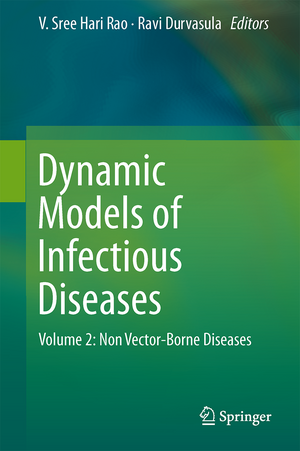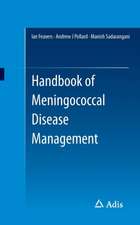Dynamic Models of Infectious Diseases: Volume 2: Non Vector-Borne Diseases
Editat de V. Sree Hari Rao, Ravi Durvasulaen Limba Engleză Hardback – 30 noi 2013
| Toate formatele și edițiile | Preț | Express |
|---|---|---|
| Paperback (1) | 943.43 lei 6-8 săpt. | |
| Springer – 22 aug 2016 | 943.43 lei 6-8 săpt. | |
| Hardback (1) | 1098.48 lei 6-8 săpt. | |
| Springer – 30 noi 2013 | 1098.48 lei 6-8 săpt. |
Preț: 1098.48 lei
Preț vechi: 1156.29 lei
-5% Nou
Puncte Express: 1648
Preț estimativ în valută:
210.20€ • 224.77$ • 175.26£
210.20€ • 224.77$ • 175.26£
Carte tipărită la comandă
Livrare economică 18 aprilie-02 mai
Preluare comenzi: 021 569.72.76
Specificații
ISBN-13: 9781461492238
ISBN-10: 1461492238
Pagini: 185
Ilustrații: XII, 259 p. 69 illus., 42 illus. in color.
Dimensiuni: 155 x 235 x 22 mm
Greutate: 0.52 kg
Ediția:2013
Editura: Springer
Colecția Springer
Locul publicării:New York, NY, United States
ISBN-10: 1461492238
Pagini: 185
Ilustrații: XII, 259 p. 69 illus., 42 illus. in color.
Dimensiuni: 155 x 235 x 22 mm
Greutate: 0.52 kg
Ediția:2013
Editura: Springer
Colecția Springer
Locul publicării:New York, NY, United States
Public țintă
ResearchCuprins
Control of Infectious Diseases: Dynamics and Informatics.- Evaluating the evolutionary dynamics of viral populations.- Percolation Methods for Seir Epidemics on Graphs.- Dynamics of tuberculosis in a developing country: Nigeria as a case study.- Component Signaling Systems of M. tuberculosis: Regulators of Pathogenicity and More.- Mycobacterium tuberculosis evolution, host-pathogen interactions and implications for tuberculosis control.- Trends in HIV transmission according to differences in numbers of sexual partnerships among men who have sex with men in China.- The Impact of Cryptococcus gattii with a Focus on the Outbreak in North America.- Modeling the Spread and Outbreak Dynamics of Avian Influenza (H5N1) Virus and its Possible Control.- Index.
Textul de pe ultima copertă
Though great advances in public health are witnessed world over in recent years, infectious diseases, besides insect vector-borne infectious diseases remain a leading cause of morbidity and mortality. Control of the epidemics caused by the non-vector borne diseases such as tuberculosis, avian influenza (H5N1), and cryptococcus gattii, have left a very little hope in the past. The advancement of research in science and technology has paved way for the development of new tools and methodologies to fight against these diseases. In particular, intelligent technology and machine-learning based methodologies have rendered useful in developing more accurate predictive tools for the early diagnosis of these diseases. In all these endeavors the main focus is the understanding that the process of transmission of an infectious disease is nonlinear (not necessarily linear) and dynamical in character. This concept compels the appropriate quantification of the vital parameters that govern these dynamics.
This book is ideal for a general science and engineering audience requiring an in-depth exposure to current issues, ideas, methods, and models. The topics discussed serve as a useful reference to clinical experts, health scientists, public health administrators, medical practioners, and senior undergraduate and graduate students in applied mathematics, biology, bioinformatics, and epidemiology, medicine and health sciences.
This book is ideal for a general science and engineering audience requiring an in-depth exposure to current issues, ideas, methods, and models. The topics discussed serve as a useful reference to clinical experts, health scientists, public health administrators, medical practioners, and senior undergraduate and graduate students in applied mathematics, biology, bioinformatics, and epidemiology, medicine and health sciences.
Caracteristici
Explores numerous aspects of non vector-borne diseases
Looks at the variety of ways in which infectious diseases can be handled
Examines procedures that can be developed for predicting the future course of these diseases
Includes supplementary material: sn.pub/extras
Looks at the variety of ways in which infectious diseases can be handled
Examines procedures that can be developed for predicting the future course of these diseases
Includes supplementary material: sn.pub/extras






